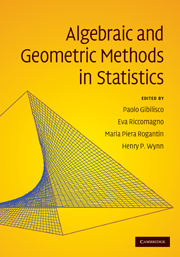Book contents
1 - Algebraic and geometric methods in statistics
Published online by Cambridge University Press: 27 May 2010
Summary
Introduction
It might seem natural that where a statistical model can be defined in algebraic terms it would be useful to use the full power of modern algebra to help with the description of the model and the associated statistical analysis. Until the mid 1990s this had been carried out, but only in some specialised areas. Examples are the use of group theory in experimental design and group invariant testing, and the use of vector space theory and the algebra of quadratic forms in fixed and random effect linear models. The newer area which has been given the name ‘algebraic statistics’ is concerned with statistical models that can be described, in some way, via polynomials. Of course, polynomials were there from the beginning of the field of statistics in polynomial regression models and in multiplicative models derived from independence models for contingency tables, or to use a more modern terminology, models for categorical data. Indeed these two examples form the bedrock of the new field. (Diaconis and Sturmfels 1998) and (Pistone and Wynn 1996) are basic references.
Innovations have entered from the use of the apparatus of polynomial rings: algebraic varieties, ideals, elimination, quotient operations and so on. See Appendix 1.7 of this chapter for useful definitions. The growth of algebraic statistics has coincided with the rapid developments of fast symbolic algebra packages such as CoCoA, Singular, 4ti2 and Macaulay 2.
If the first theme of this volume, algebraic statistics, relies upon computational commutative algebra, the other one is pinned upon differential geometry.
- Type
- Chapter
- Information
- Algebraic and Geometric Methods in Statistics , pp. 1 - 24Publisher: Cambridge University PressPrint publication year: 2009



